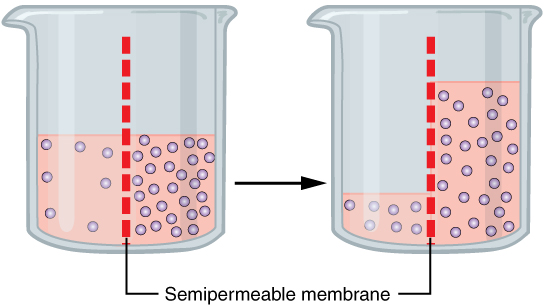Contents
Transport
Transport Across Membranes
All cells and organelle membranes have the same structure. The membranes are described as a fluid-mosaic model due to the mixture and movement of the phospholipids, proteins, glycoproteins, and glycolipids they are made of. Cholesterol is also present in some membranes, which restricts the lateral movement of other molecules in the membrane. This is useful as it makes the membrane less fluid at high temperatures and prevents water and dissolved ions from leaking out of the cell.

The phospholipids align as a bilayer due to the hydrophilic heads being attracted to water and the hydrophobic tails being repelled by water.
Proteins are embedded across the cell surface membrane as either peripheral (do not extend completely across the membrane) or integral (span across from one side of the bilayer to the other). The peripheral proteins provide mechanical support, or they are connected to proteins or lipids to make glycoproteins and glycolipids. The function of these is cell recognition, as receptors.
The integral proteins are protein carriers or carrier proteins involved in the transport of molecules across the membrane.
Protein channels form tubes that fill with water to enable water-soluble ions to diffuse, whereas the carrier proteins will bind with other ones and larger molecules, such as glucose and amino acids, and change shape to transport them to the other side of the membrane.
All of these molecules arranged within the phospholipid bilayer create the partially permeable membrane, which is the cell-surface membrane.
Simple Diffusion
There are five key modes of transport in and out of cells: simple diffusion, facilitated diffusion, osmosis, active transport, and co-transport. Simple diffusion is the net movement of molecules from an area of higher concentration to an area of lower concentration until equilibrium is reached. This process does not require ATP.

For the molecules to move, they do have energy, but this is due to the kinetic energy that they possess to enable them to constantly move in fluids. For molecules to diffuse across the membrane, they must be lipid-soluble and small. Only a few molecules can, for example, oxygen and carbon dioxide.
Facilitated Diffusion
This is also a passive process (it does not require ATP) but it differs from simple diffusion as proteins are used to transport molecules. The movement of ions and polar molecules, which cannot simply diffuse, can be transported across membranes by facilitated diffusion using protein channels and carrier proteins. Protein channels form tubes filled with water, and this enables water-soluble ions to pass through the membrane. This is still selective, as the channel proteins only open in the presence of certain ions when they bind to the protein.

Carrier proteins will bind with a molecule, such as glucose, which causes a change in the shape of the protein. This shape change enables the molecule to be released to the other side of the membrane.
Osmosis
Osmosis is the movement of water. It is the movement of water from an area of higher water potentials to an area of lower water potential across a partially permeable membrane. Water potential is the pressure created by water molecules and is measured in kPa and represented with the symbol Ψ. Pure water has a water potential of zero, so when solutes are dissolved in water, the water potential will become negative. The more negative the water potential, the more solute must be dissolved in it.

An isotonic solution is when the water potential is the same in the solution and the cell within the solution. Hypotonic is when the water potential of a solution is more positive (closer to zero) than the cell. Hypertonic is when the water potential of a solution is more negative than the cell.
In animal cells, if they are placed in a hypotonic solution such as pure water, a lot of water will move into the cell by osmosis. As animal cells do not have a cell wall, the pressure will cause the cell to burst. Plant cells do not burst because of the strengthened cell wall. Both animal and plant cells will shrink and become shrivelled if they are placed in hypertonic solutions, due to large volumes of water leaving the cell by osmosis.


Active Transport
This is the movement of molecules and ions from an area of lower concentration to an area of higher concentration (against the concentration gradient) using ATP and carrier proteins. The carrier proteins act as pumps to move substances across the membrane. This is very selective, as only certain molecules can bind to the carrier proteins to be pumped.

Certain molecules can bind to the receptor site on carrier proteins. ATP will bind to the protein on the inside of the membrane and is hydrolysed into ADP and Pi. This causes the protein to change shape and open towards the inside of the membrane. This causes the molecule to be released on the other side of the membrane. The Pi molecule is then released from the protein, and this results in the protein reverting to its original shape. This is how ATP and carrier proteins are used in active transport.
Co-Transport
A common example of co-transport is in the absorption of sodium and glucose ions from the small intestines, specifically the ileum.
Sodium ions must be transported by active transport from the epithelial cells to the blood via a protein carrier. This lowers the concentration of sodium in the epithelial cell to create a concentration gradient between the ileum and the epithelial cell.
